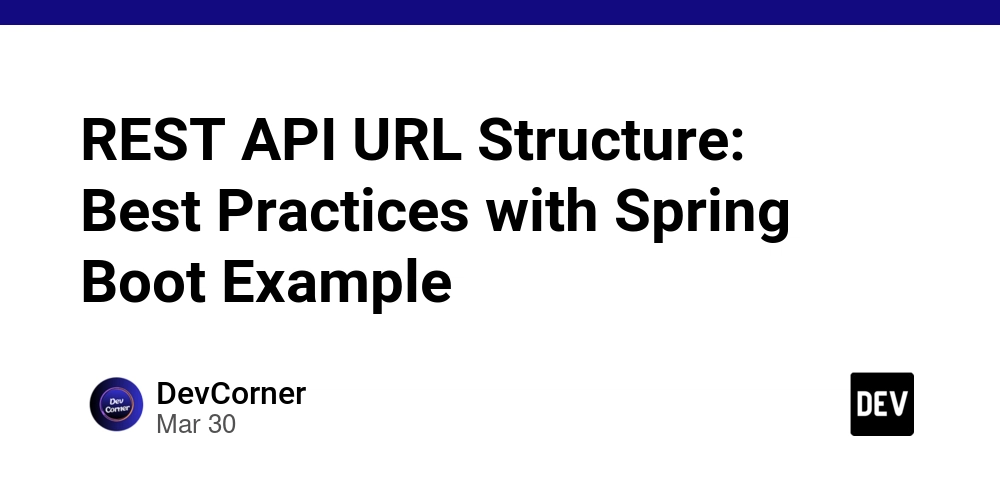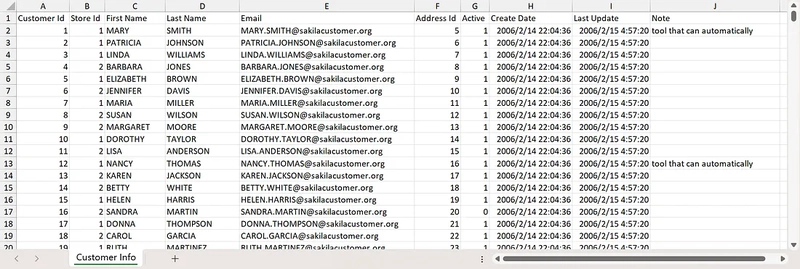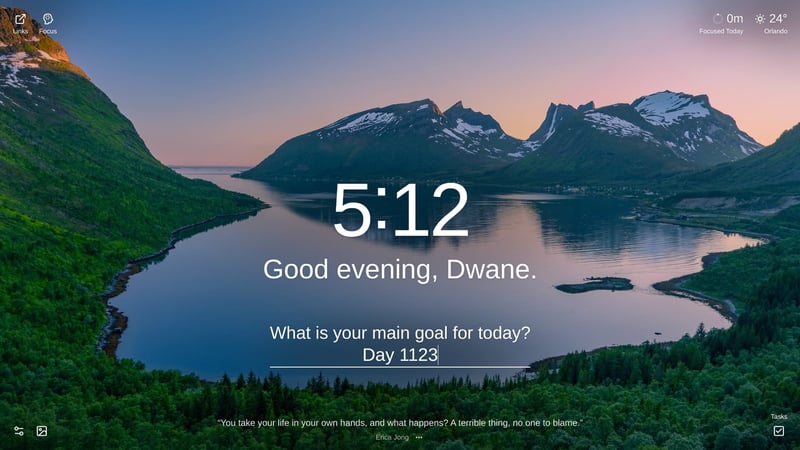REST API URL Structure: Best Practices with Spring Boot Example
Introduction A well-designed REST API URL structure is crucial for building scalable, readable, and maintainable APIs. In this blog, we will break down the components of a REST API URL, discuss best practices, and implement them in Spring Boot with a complete example. 1. General REST API URL Structure A standard REST API URL follows this pattern: https://api.example.com/{version}/{resource}/{resource-id}/{sub-resource} Breakdown: https:// → Secure protocol (HTTPS is preferred) api.example.com → Domain name or API host {version} → API versioning (e.g., v1, v2) {resource} → Plural noun representing the resource (e.g., users, products) {resource-id} → Unique identifier for a resource (e.g., users/123) {sub-resource} → Nested resource related to the main resource (e.g., users/123/orders) 2. Components of REST API URL A. Versioning in REST API Versioning ensures backward compatibility and can be implemented in different ways: URL Path Versioning (Recommended) https://api.example.com/v1/users Header Versioning GET /users Accept: application/vnd.example.v1+json Query Parameter Versioning GET /users?version=1 B. Resource Naming (Use Plural Nouns) Always use plural nouns for resources: GET /v1/users → Get all users GET /v1/users/123 → Get user with ID 123 POST /v1/users → Create a new user PUT /v1/users/123 → Update user 123 DELETE /v1/users/123 → Delete user 123 C. Sub-Resources for Relationships Use sub-resources to represent relationships: GET /v1/users/123/orders → Get orders of user 123 GET /v1/users/123/orders/456 → Get order 456 of user 123 D. Query Parameters for Filtering, Sorting, and Pagination Filtering: GET /v1/products?category=electronics&brand=apple Sorting: GET /v1/products?sort=price_asc Pagination: GET /v1/products?page=2&limit=20 Offset-based Pagination: GET /v1/products?offset=40&limit=20 E. Actions that Don’t Fit CRUD (Use Verbs as Subpaths) For actions beyond CRUD, use verbs: POST /v1/users/123/activate → Activate user 123 POST /v1/orders/789/cancel → Cancel order 789 F. Status and Error Handling Use appropriate HTTP status codes: 200 OK → Successful request 201 Created → Resource created 400 Bad Request → Client error 404 Not Found → Resource not found 500 Internal Server Error → Server issue 3. Best Practices for REST API URL Design ✅ Use nouns for resources (/users instead of /getUsers) ✅ Use hyphens (-) instead of underscores (_) in URLs (/user-profiles not /user_profiles) ✅ Use lowercase letters (/orders instead of /Orders) ✅ Avoid file extensions (/users.json is unnecessary) ✅ Keep URLs short and intuitive 4. Spring Boot Implementation Let's implement these best practices in a Spring Boot REST API for managing users and orders. A. User Controller with Versioning, Pagination, Filtering, Offset-based Pagination, and Sorting @RestController @RequestMapping("/v1/users") public class UserController { @Autowired private UserRepository userRepository; @GetMapping public ResponseEntity getAllUsers( @RequestParam(required = false) String name, @RequestParam(defaultValue = "0") int page, @RequestParam(defaultValue = "10") int size, @RequestParam(defaultValue = "id") String sortBy, @RequestParam(defaultValue = "asc") String sortDir, @RequestParam(required = false) Integer offset) { Sort sort = sortDir.equalsIgnoreCase("desc") ? Sort.by(sortBy).descending() : Sort.by(sortBy).ascending(); Pageable pageable = offset != null ? PageRequest.of(offset / size, size, sort) : PageRequest.of(page, size, sort); Page users; if (name != null) { users = userRepository.findByNameContaining(name, pageable); } else { users = userRepository.findAll(pageable); } return ResponseEntity.ok(users.getContent()); } @GetMapping("/{id}") public ResponseEntity getUserById(@PathVariable Long id) { return userRepository.findById(id) .map(ResponseEntity::ok) .orElseGet(() -> ResponseEntity.notFound().build()); } @PostMapping public ResponseEntity createUser(@RequestBody User user) { return ResponseEntity.status(HttpStatus.CREATED).body(userRepository.save(user)); } @PutMapping("/{id}") public ResponseEntity updateUser(@PathVariable Long id, @RequestBody User updatedUser) { return userRepository.findById(id).map(user -> { user.setName(updatedUser.getName()); user.setEmail(updatedUser.getEmail()); return ResponseEntity.ok(userRepository.save(user)); }).orElseGet(() -> Resp

Introduction
A well-designed REST API URL structure is crucial for building scalable, readable, and maintainable APIs. In this blog, we will break down the components of a REST API URL, discuss best practices, and implement them in Spring Boot with a complete example.
1. General REST API URL Structure
A standard REST API URL follows this pattern:
https://api.example.com/{version}/{resource}/{resource-id}/{sub-resource}
Breakdown:
-
https://→ Secure protocol (HTTPS is preferred) -
api.example.com→ Domain name or API host -
{version}→ API versioning (e.g.,v1,v2) -
{resource}→ Plural noun representing the resource (e.g.,users,products) -
{resource-id}→ Unique identifier for a resource (e.g.,users/123) -
{sub-resource}→ Nested resource related to the main resource (e.g.,users/123/orders)
2. Components of REST API URL
A. Versioning in REST API
Versioning ensures backward compatibility and can be implemented in different ways:
- URL Path Versioning (Recommended)
https://api.example.com/v1/users
- Header Versioning
GET /users
Accept: application/vnd.example.v1+json
- Query Parameter Versioning
GET /users?version=1
B. Resource Naming (Use Plural Nouns)
Always use plural nouns for resources:
GET /v1/users → Get all users
GET /v1/users/123 → Get user with ID 123
POST /v1/users → Create a new user
PUT /v1/users/123 → Update user 123
DELETE /v1/users/123 → Delete user 123
C. Sub-Resources for Relationships
Use sub-resources to represent relationships:
GET /v1/users/123/orders → Get orders of user 123
GET /v1/users/123/orders/456 → Get order 456 of user 123
D. Query Parameters for Filtering, Sorting, and Pagination
Filtering:
GET /v1/products?category=electronics&brand=apple
Sorting:
GET /v1/products?sort=price_asc
Pagination:
GET /v1/products?page=2&limit=20
Offset-based Pagination:
GET /v1/products?offset=40&limit=20
E. Actions that Don’t Fit CRUD (Use Verbs as Subpaths)
For actions beyond CRUD, use verbs:
POST /v1/users/123/activate → Activate user 123
POST /v1/orders/789/cancel → Cancel order 789
F. Status and Error Handling
Use appropriate HTTP status codes:
-
200 OK→ Successful request -
201 Created→ Resource created -
400 Bad Request→ Client error -
404 Not Found→ Resource not found -
500 Internal Server Error→ Server issue
3. Best Practices for REST API URL Design
✅ Use nouns for resources (/users instead of /getUsers)
✅ Use hyphens (-) instead of underscores (_) in URLs (/user-profiles not /user_profiles)
✅ Use lowercase letters (/orders instead of /Orders)
✅ Avoid file extensions (/users.json is unnecessary)
✅ Keep URLs short and intuitive
4. Spring Boot Implementation
Let's implement these best practices in a Spring Boot REST API for managing users and orders.
A. User Controller with Versioning, Pagination, Filtering, Offset-based Pagination, and Sorting
@RestController
@RequestMapping("/v1/users")
public class UserController {
@Autowired
private UserRepository userRepository;
@GetMapping
public ResponseEntity<List<User>> getAllUsers(
@RequestParam(required = false) String name,
@RequestParam(defaultValue = "0") int page,
@RequestParam(defaultValue = "10") int size,
@RequestParam(defaultValue = "id") String sortBy,
@RequestParam(defaultValue = "asc") String sortDir,
@RequestParam(required = false) Integer offset) {
Sort sort = sortDir.equalsIgnoreCase("desc") ? Sort.by(sortBy).descending() : Sort.by(sortBy).ascending();
Pageable pageable = offset != null ? PageRequest.of(offset / size, size, sort) : PageRequest.of(page, size, sort);
Page<User> users;
if (name != null) {
users = userRepository.findByNameContaining(name, pageable);
} else {
users = userRepository.findAll(pageable);
}
return ResponseEntity.ok(users.getContent());
}
@GetMapping("/{id}")
public ResponseEntity<User> getUserById(@PathVariable Long id) {
return userRepository.findById(id)
.map(ResponseEntity::ok)
.orElseGet(() -> ResponseEntity.notFound().build());
}
@PostMapping
public ResponseEntity<User> createUser(@RequestBody User user) {
return ResponseEntity.status(HttpStatus.CREATED).body(userRepository.save(user));
}
@PutMapping("/{id}")
public ResponseEntity<User> updateUser(@PathVariable Long id, @RequestBody User updatedUser) {
return userRepository.findById(id).map(user -> {
user.setName(updatedUser.getName());
user.setEmail(updatedUser.getEmail());
return ResponseEntity.ok(userRepository.save(user));
}).orElseGet(() -> ResponseEntity.notFound().build());
}
@DeleteMapping("/{id}")
public ResponseEntity<Void> deleteUser(@PathVariable Long id) {
userRepository.deleteById(id);
return ResponseEntity.noContent().build();
}
}
Conclusion
Designing a RESTful API URL properly improves usability, scalability, and maintainability. By following best practices and implementing them in Spring Boot, you can build high-quality, developer-friendly APIs with versioning, pagination, offset-based pagination, sorting, and filtering.
Would you like to extend this with authentication or advanced query capabilities? Let me know in the comments!











































































































































































![[The AI Show Episode 142]: ChatGPT’s New Image Generator, Studio Ghibli Craze and Backlash, Gemini 2.5, OpenAI Academy, 4o Updates, Vibe Marketing & xAI Acquires X](https://www.marketingaiinstitute.com/hubfs/ep%20142%20cover.png)



























































































































![[FREE EBOOKS] The Kubernetes Bible, The Ultimate Linux Shell Scripting Guide & Four More Best Selling Titles](https://www.javacodegeeks.com/wp-content/uploads/2012/12/jcg-logo.jpg)



![From drop-out to software architect with Jason Lengstorf [Podcast #167]](https://cdn.hashnode.com/res/hashnode/image/upload/v1743796461357/f3d19cd7-e6f5-4d7c-8bfc-eb974bc8da68.png?#)






































































































.png?#)




.jpg?#)































_Christophe_Coat_Alamy.jpg?#)









































































































![Rapidus in Talks With Apple as It Accelerates Toward 2nm Chip Production [Report]](https://www.iclarified.com/images/news/96937/96937/96937-640.jpg)








































































































































